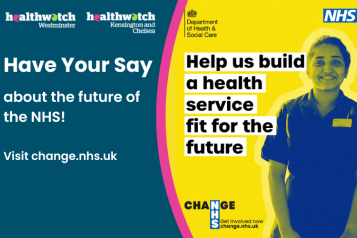NHS 10-Year Plan: what do people want to see?

As part of the Government’s public consultation that was held to develop the NHS 10-Year Plan, Healthwatch Kensington and Chelsea, Healthwatch Westminster and Healthwatch Brent delivered a series of public events. These sessions, in partnership with the North West London Integrated Care Board, welcomed local residents from diverse demographic backgrounds to share their thoughts on the future direction of the NHS.
Based on the findings from our local events as well as other events that were delivered across the country, Healthwatch England has set out four priorities for the NHS 10-Year Plan for patients, their families, and their carers.
1. Putting patients first
The Government’s plan focuses on three shifts to help repair the NHS over the next decade:
- Moving more care from hospitals to communities
- Making better use of technology, shifting from an analogue to a digital NHS
- Focusing on preventing sickness, not just treating it
Although many people have told us that they want to see those shifts from the NHS in England, it’s vital to put people’s needs and preferences at the forefront. This includes a choice of where to be treated and options for digital and offline communications and services from NHS teams.
Choice of care
Under the NHS Constitution, people have the right to make decisions about their care, have preferences met and choose where they receive healthcare. People’s choice is often not just a matter of personal preference but essential to access due to communication requirements, affordability, or work or caring commitments.
However, many people have expressed that NHS decisions often seem to prioritise the needs of healthcare teams over those of patients. While it is essential for policies and reforms to support NHS staff, this should not come at the cost of patients being able to access the care they need in a way that works for them.
What needs to happen?
In ten years, we want an NHS led by people's needs.
- If more care moves into the community, then existing hospital-based support, such as with travel costs, must follow the patient.
- If the NHS delivers more care through the NHS App in ten years, choice must be at the heart of this shift. People who prefer analogue communications must have that choice. The NHS App must do all it can to provide people with informed choices about the available options and services.
- If more people are to get care closer to their homes, healthcare leaders must ensure support is in place so that unpaid carers don't take on more support duties or incur new costs, such as travel costs or electricity from machines used at home.
- The NHS App must enable two-way communication, allowing people to give and receive updates on their condition, appointments, vaccinations and prescriptions, and to give real-time feedback on their experiences.
- The NHS App should provide more features, including real-time trackers for referrals and waiting times, easy access to 'customer support', and a better directory of services, including signposting to Healthwatch England and local Healthwatch services.
- The Plan must ensure that no one is left behind by digital care and that people can choose to receive any support provided through the NHS App in appropriate formats.
2. Getting the basics right
People have expressed to us that they find it difficult to understand and navigate an often complicated and confusing health system. This includes people being passed between teams who lack clarity about who does what, and what support people may need to access their care.
Disabled people and those with sensory impairments often face greater challenges in contacting healthcare teams in ways that suit their needs. They also often receive information in formats they can’t access because their communication requirements are not properly recorded in health systems.
We’ve also heard stories of people whose NHS letters arrived after the scheduled appointment or being delivered to the wrong address, and instances where referrals were lost in the system. Inaccurate and missing information in people’s medical records can lead to delays in receiving care and pose significant risks to patient safety.
What needs to happen?
In ten years, we want the NHS to get the basics right.
- By 2035, transitions across services should feel seamless, and reforms must simplify navigation for people so they do not have to repeat their stories to different teams.
- Greater support with health literacy will also ensure the 10-Year Health Plan leaves nobody behind.
- Investing in admin systems and hiring and training NHS care navigators would help wrap care around people’s needs, support navigation of NHS services, support the shift to digital care, and provide extra support with admin processes.
- Strengthening the Accessible Information Standard (AIS) will ensure that services meet people’s communication needs and consistently record the formats in which they should receive their healthcare. This will prevent people from missing out on vital care.
3. Tackling health inequalities
People who already face inequalities are more likely to be affected by problems in the NHS.
Some examples of inequalities that affect access to healthcare include:
- People from ethnic minority backgrounds, disabled people, unpaid carers, and women are more likely to face longer waits for and worse experiences of planned hospital care.
- People on lower incomes are less confident in accessing daytime GP appointments. The cost of services such as dentists or associated expenses with booking appointments such as the cost of a phone call, internet access, or travel costs are factors that can deter them from accessing healthcare.
- Neurodiverse people are more likely to report a negative experience of getting a referral from general practice to community and secondary care.
- Autistic people, visually impaired people, deaf people, those with dyslexia, and people relying on translators face persistent challenges receiving inaccessible communication from NHS teams.
All these examples exacerbate the lack of trust many communities feel in health and care services, including a reluctance to give feedback on experiences and to engage with services.
What needs to happen?
In ten years, access to NHS services should be equitable, and everyone should have equal opportunities and support to get the help they need.
- We need to see concerted efforts to change the NHS into an equal and fair health service where everyone can access the care they need, regardless of factors like age, gender, or where they live.
- The 10-Year Plan should start by examining ways of ensuring that all forms of national data can be broken down by demographics. Right now, nationally collected data does not always break down the experiences of care by different groups, meaning that inequalities are often not visible.
- Patients who remain ‘analogue’ (due to digital exclusion from cost, low skills or disability), must not be left behind by a ‘digital NHS’ and still be able to use ‘offline’ channels. The NHS must provide people with alternatives as well, so that everyone can access services and receive communications via their preferred format, including in person, over the phone, or via letters.
4. Measuring people’s experience of care
Reducing waiting times for planned NHS care and in A&E departments has been a key focus for NHS leaders in recent years. Although this is important to patients, their experience of waiting, comfort, choice of care, and communication with services are just as key.
Current performance measures focus on hospital care and tend to measure numbers through the door and length of wait. However, measuring four-hour waits in A&E or 18-week waits for elective appointments tells us nothing about people’s experiences while waiting, including the quality of non-clinical support they receive and their experiences across multiple pathways and services.
What needs to happen?
In ten years, NHS performance should be measured against the things that matter to people.
- The NHS 10-Year Plan should measure people’s experience of care as part of performance monitoring.
- This should include access to care, how much choice people have, the quality, quantity, and accessibility of communications from services, and whether the NHS buildings they visit are fit for purpose.
- An integration measure of how well services transition patients between each other will also be vital to ensure patients don’t have to repeat their story and that transitions are safe and planned.
Find out more about the priorities that Healthwatch England has outlined for the 10-Year Health Plan.

